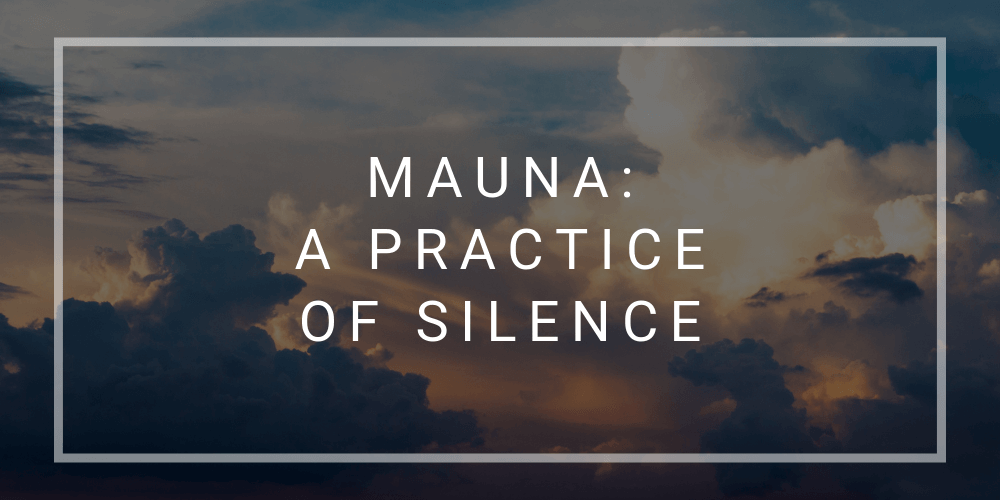Mauna: A Practice of Silence

Author: Jacky Rae
Once the disciple approached his Gruu and asked him where that Eternal, the Supreme Infinite, the Brahman of the Upanishadas, was. The master spoke not. The disciple asked him again and again, but the master did not open his mouth. He kept perfect silence. At last the teacher said: “I have been telling you again and again, but you do not understand me. What am I to do? That Brahman, the Infinite, the Eternal, cannot be explained. But, by deep silence, know It. There is no other place for Him to dwell in, but the one eternal deep silence! Ayam atma santah. This Atman is Silance”
Practicing the Art of Silence
Practicing the art of silence amid chaos is possible. Our thoughts have the ability to drown out attentions, noise, or whatever is going on around us. Think about when you are engaged in a stimulating conversation your attention is typically diverted from other stimuli—even if it’s a loud construction sight. Or when you are deep in thought and get lost because you weren’t paying attention. Our thoughts are powerful; silence can help shape them in a positive way by bringing awareness to their content. Cultivating a practice of silence is like taking time to visit an old friend; you are able to catch up with yourself, to notice and connect to stillness.
Regular moments of silence develop concentration. Try turning off your phone the next time you are with someone you love. Sit under a tree or in nature and take it all in without playing music (not that music is a bad thing; it too can bring peace and healing). Nature has a profound wisdom that in the silence speaks to us.
Silence teaches us to be better listeners. Everyone wants to feel heard, by learning to allow silence to be apart of a conversation; you learn to listen to not only what is said but what is not said as well. Silence gives us power through clarity. When we become silent we can build on our inner strength. Think about those times when your words may have muddled up a situation or inadvertently been misunderstood. Silence often stands the test of time where the truth can quietly step into the light.
The following are a few other techniques to help you develop your own personal practice of silence:
- Create a time for your silence by making it a ritual. Perhaps you spend the mornings in silence or the evening after the kids are in bed. (Children can practice silence as well and they reap the same benefits as adults). Or maybe late afternoon after work and before you hit the traffic heading home.
- Savor your silent practice by protecting it. Make it just as important as brushing your teeth even if for only a few minutes.
- Find your spot and make it your own: under a favorite tree, at a park, in a room at work. Turn off the lights, light a candle.
- Turn off your devices, step away from the computer and the deluge of stimuli.
- If it helps, close your eyes and focus on your breath. Inhaling and exhaling slowly to the count of four for a few repetitions.
God or Brahamn is Supreme Silence. Soul is Silence. Peace is Silence. Atman is Silence. Silence is the language of Brahman. Silence is the language of the heart. Silence is the language of the sage. Silence is immense strength. Silence is great eloquence.
Silence is God. Silence is the substratum for this body, Prana and the Senses. Silence is the background for this sense-universe. Silence is power. Silence is a living force. Silence is the only reality.
— Bliss Divine – Swami Sivananda
More From Our Ayurvedic Learning Center

How to Make Ghee – The Ayurvedic Way
About this recipe Ghee is a staple in ayurveda so it's always good to know how to make your own that way you can keep an eye on the quality and save a few bucks! Ghee is sattvic, increases agni, helps to move āma to be detoxified and is unctuous helping to nourish...

Journey into Ayurvedic Wisdom: Unveiling the Bṛhat Trayī
At the core of Ayurvedic knowledge lies the Bṛhat Trayī – the three primary texts that weave together the intricate tapestry of this time-honored tradition. In this blog post, we embark on an exploration of the Caraka Saṃhitā, Suśruta Saṃhitā, and Aṣṭāṅga Hṛdaya,...

5 Tangible Ways to Practice Yogic Philosophy
The roots of yoga go back thousands of years and yogic philosophy has emerged from so many different texts over the years that the number of teachings is overwhelmingly big. It can be easy to get lost in philosophising and not be sure on how to apply them to our lives...
